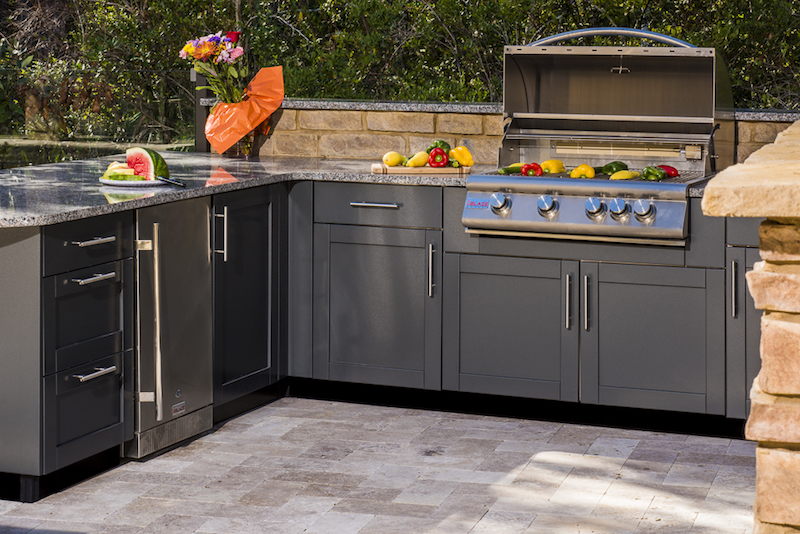
Outdoor kitchens are one of the most loved features of any backyard space. Whether you’re hosting summer BBQs or enjoying quiet morning breakfasts outside, they add function, luxury, and value to your property. But with constant exposure to food, grease, weather, and pests, these areas can get dirty fast. The good news? Power washing is one of the most effective ways to clean and restore outdoor kitchens—as long as it’s done correctly 💦.
In this guide, we’ll walk through the benefits of power washing your outdoor cooking area, step-by-step instructions, safety tips, and how to avoid damage to your valuable fixtures and finishes.
🍔 Why Outdoor Kitchens Get So Dirty
Outdoor kitchens face a tough combination of conditions:
- Grease splatter from grilling
- Spilled marinades or drinks on countertops and floors
- Pollen, dust, and dirt carried by wind
- Bird droppings, bugs, and cobwebs near overhead covers
- Mold or algae in damp or shaded areas
All of this accumulates quickly and can create slippery surfaces, attract pests, and make your beautiful kitchen look like a mess.
✅ Benefits of Power Washing Outdoor Kitchens
Power washing does more than just make surfaces look clean:
- Sanitizes cooking and prep areas
- Removes built-up grease and stains
- Eliminates mold, mildew, and bacteria
- Extends the life of stone, concrete, and wood finishes
- Improves traction on patios and walkways
- Restores the appearance of stainless steel and appliances
If done regularly, power washing can help maintain both the beauty and safety of your outdoor kitchen year-round.
Browse Amazon Here For Top Rated Power Washers And Accessories
🔍 What to Power Wash—and What to Avoid
Some parts of your outdoor kitchen can handle pressure washing better than others. Here’s a quick breakdown:
| Surface/Feature | Safe to Power Wash? | Notes |
|---|---|---|
| Concrete countertops | ✅ Yes | Use mild detergent |
| Stone or paver flooring | ✅ Yes | Clean joints carefully |
| Stainless steel appliances | ⚠️ With caution | Use low pressure; avoid controls |
| Outdoor cabinets (PVC/wood) | ⚠️ Low pressure only | Use soft wash settings |
| Electrical outlets | ❌ No | Cover and avoid spraying directly |
| Grill hood and burners | ❌ No | Clean by hand with degreaser |
🧽 Step-by-Step Guide to Power Washing an Outdoor Kitchen
1. Remove Loose Debris and Furniture
Move chairs, rugs, covers, and decorations out of the way. Sweep or blow away leaves, food particles, and dirt first.
2. Cover Sensitive Equipment
Use plastic or waterproof tarps to cover:
- Grills and burners
- Outdoor fridges or wine coolers
- Electrical outlets or lighting fixtures
- Exposed gas lines or vents
You want to avoid any water intrusion into electrical or gas components ⚠️.
3. Apply a Degreasing Cleaner
Use a cleaner that’s safe for stone, concrete, or composite surfaces. Let it sit for 5–10 minutes to loosen up the grease and dirt before rinsing.
4. Set Your Pressure Washer Properly
- Use a 25° or 40° nozzle tip
- Keep the pressure between 1,200–2,000 PSI
- Hold the wand at a 45-degree angle, 12–18 inches away
- Spray in smooth, overlapping strokes
Avoid focusing too long on one spot, especially near caulking or grout.
5. Rinse From Top to Bottom
Start with the higher surfaces like countertops or backsplashes and work your way down to the flooring. This allows gravity to help with drainage and avoids re-soiling clean areas.
6. Dry and Inspect
Let everything air dry for a few hours. Check for missed spots, discoloration, or water pooling. Wipe down stainless steel surfaces with a dry microfiber cloth to prevent water spotting.
🌿 Eco-Friendly Tips
Outdoor kitchens are often surrounded by gardens and grass. Be mindful of run-off:
- Use biodegradable cleaners
- Avoid bleach-based products
- Rinse with minimal water pressure near plants
- Block drains if using heavy detergents
Protecting your landscaping ensures that your power washing doesn’t do unintended harm 🌍.
Browse Amazon Here For Eco-Friendly Pressure Washing Detergents
🔧 Post-Cleaning Maintenance Tips
After your outdoor kitchen is freshly cleaned:
- Reseal stone countertops or pavers if needed
- Apply a protective spray to stainless steel
- Check for cracks in grout or joints
- Tighten any loose cabinet doors or hinges
- Store cleaning tools and power washer safely
Adding a simple maintenance step after cleaning helps prolong the life of your space.
🧠 Pro Tips
- Power wash your outdoor kitchen at least 2–3 times a year depending on usage
- Avoid power washing during extremely cold or windy days
- Use hot water pressure washers if possible for greasy areas
- Don’t forget to clean your outdoor trash cans and recycling bins too!
✅ Final Thoughts: A Fresh Kitchen is a Functional Kitchen
Your outdoor kitchen is a serious investment in comfort, luxury, and lifestyle. Power washing is one of the easiest ways to protect that investment, keep it looking sharp, and ensure a safe and sanitary space for you and your guests 🍽️💧.
So don’t wait for the grime to take over—give your outdoor kitchen the spa treatment it deserves with a seasonal deep clean.
Browse Amazon Here For Top Rated Power Washers And Accessories



